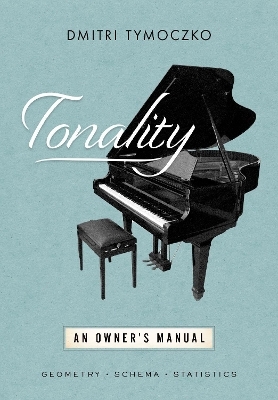
Tonality
Oxford University Press Inc (Verlag)
978-0-19-757710-3 (ISBN)
Dmitri Tymoczko is a composer and music theorist who teaches at Princeton University. Widely recognized as one of the world's leading music theorists, his music has been performed all over the world.
Preface and Acknowledgements
1. Implicit musical knowledge
1. Gesualdo's trick
2. The quadruple hierarchy
3. Philosophy
4. Statistics
5. Schema
6. Outline
Prelude: transposition along a collection
2. Rock logic
1. A melodic principle
2. A harmonic principle
3. A first chord-loop family
4. Two more families
5. Shepard-tone passacaglias
6. Minor triads and other trichords
7. A fourth family
8. Other modalities
9. Function and retrofunction
10. Continuity or reinvention?
Prelude: the Tinctoris transform
3. Line and configuration
1. The imperfect system
2. Voice exchanges
3. Other intervals
4. The circle of diatonic triads
5. Voice exchanges and multiple chord types
6. Four-voice triadic counterpoint
7. Counterpoint within the chord
8. Seventh chords
9. Harmony and counterpoint
Prelude: sequence and function
4. Repetition
1. Repetition reimagined
2. Repeating contrapuntal patterns
3. The geometry of two-voice sequences
4. Three voices and the circle of triads
5. Three voices arranged 2+1
6. Four voices
7. Contrary-motion sequences
8. Melodic sequences and near sequences
9. Near sequences
10. Sequences as reductional targets
Prelude: three varieties of analytical reduction
5. Nonharmonic tones
1. The first practice and the SNAP system
2. Schoenberg's critique
3. Monteverdi's "Ohimè"
4. The standardized second practice
5. A loophole
6. After nonharmonicity
Prelude: functional and scale-degree analysis
6. The origins of functional harmony
1. The logical structure of protofunctionality
2. Similarities and differences
3. Origin and meaning
4. Harmony and polyphony
5. The Pope Marcellus Kyrie
6. A broader perspective
7. "I Cannot Follow"
Prelude: could the Martians understand our music?
7. Functional progressions
1. A theory of harmonic cycles
2. A more principled view
3. Rameau and Bach
4. Functional melody, functional harmony
5. Fauxbourdon and linear idioms
6. Sequences
7. Bach the dualist
Prelude: chromatic or diatonic?
8. Modulation
1. Two models of key distance
2. Enharmonicism and loops in scale space
3. Minor keys
4. Modulatory schemas
5. Up and down the ladder
6. Modal homogenization and scalar voice leading
7. Generalized set theory
Prelude: hearing and hearing-as
9. Melodic strategies
1. Strategy and reduction
2. Two models of the phrase
3. Chopin and the Prime Directive
4. An expanded vocabulary of melodic templates
5. Simple harmonic hierarchy
6. The four-part phrase
7. Grouping, melody, harmony
8. Beyond the phrase: hierarchy at the level of the piece
Prelude: why Beethoven?
10. Beethoven theorist
1. Meet the Ludwig
2. From schema to flow
3. The Tempest
4. The Fifth Symphony
5. The "Pastorale" sonata, op. 28
6. Schubert's Quartettsatz
7. The prelude to Lohengrin
11. Conclusion
12. Appendix 1: Fundamentals
13. Appendix 2: Deriving the spiral diagrams
14. Appendix 3: From sequence to transformation
15. Appendix 4: Music theory and corpus analysis
Terms and Abbreviations
Bibliography
| Erscheinungsdatum | 17.04.2023 |
|---|---|
| Reihe/Serie | OXFORD STUDIES IN MUSIC THEORY |
| Zusatzinfo | 698 |
| Verlagsort | New York |
| Sprache | englisch |
| Maße | 244 x 188 mm |
| Gewicht | 1247 g |
| Themenwelt | Kunst / Musik / Theater ► Musik ► Musiktheorie / Musiklehre |
| ISBN-10 | 0-19-757710-5 / 0197577105 |
| ISBN-13 | 978-0-19-757710-3 / 9780197577103 |
| Zustand | Neuware |
| Informationen gemäß Produktsicherheitsverordnung (GPSR) | |
| Haben Sie eine Frage zum Produkt? |
aus dem Bereich


